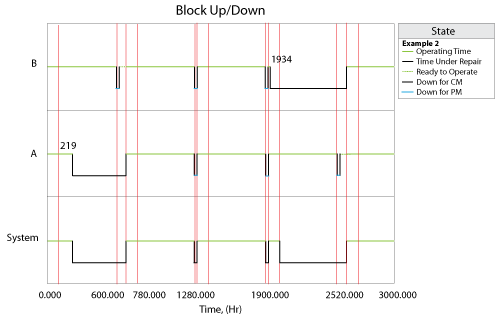BlockSim Example: Phase with Failure or Success Paths: Difference between revisions
Dingzhou Cao (talk | contribs) |
Dingzhou Cao (talk | contribs) |
||
| Line 43: | Line 43: | ||
The Block Up/Down plot is as followings: | The Block Up/Down plot is as followings: | ||
#At 219, Block A fails in Phase 2. This failure brings the system down. However, since the | #At 219, Block A fails in Phase 2. This failure brings the system down. However, since the path from Phase 2 to Maintenance Phase 3 is a success path, system doesn't go into Maintenance Phase 3 immediately. It would go into Maintenance Phase 3 after the Phase 2. Block A gets CM and Block B gets PM in there. | ||
#At 1934, Block B fails in Phase 1. This failure doesn't bring system down because in Phase 1, system is in parallel structure. After Phase 1, system goes into Phase 2 and the failure of Block B brings system down in Phase 2. However, system doesn't go into Maintenance Phase 3 immediately because the | #At 1934, Block B fails in Phase 1. This failure doesn't bring system down because in Phase 1, system is in parallel structure. After Phase 1, system goes into Phase 2 and the failure of Block B brings system down in Phase 2. However, system doesn't go into Maintenance Phase 3 immediately because the path between them is success path. System goes into Maintenance Phase 3 after Phase 2 and Block B gets CM and Block A gets PM there.[[Image:Phase Up Down plot for Example 2.png|thumb|center|500px]] | ||
[[Category:BlockSim_Examples]] | [[Category:BlockSim_Examples]] | ||
Revision as of 20:21, 21 October 2011
Phase with Failure or Success Paths
Purposes
The purposes of this example are to illustrate how to apply failure or success paths in Phase simulation.
- For a failure path, on system failure, system go to somewhere immediately when failure occurs.
- For a success path, if there is no system failure during this phase, system goes to somewhere by the end of the current phase.
RBDs for Phase and settings
The RBDs for Phase 1 and Phase 2 are as followings:
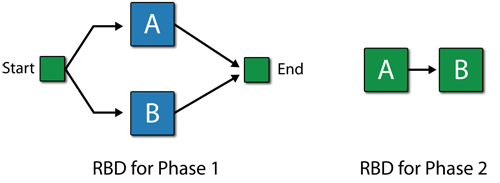
In Phase 1, Block A follows Weibull distribution with Beta = 1.5 and Eta = 1000 hours. Block B follows Weibull distribution with Beta = 1.5 and Eta = 1200 hours. No maintenance.
In Phase 2, Block A follows Weibull distribution with Beta = 1.5 and Eta = 900 hours. Block B follows Weibull distribution with Beta = 1.5 and Eta = 1150 hours. No maintenance.
Example 1
The Phase diagram is as followings:
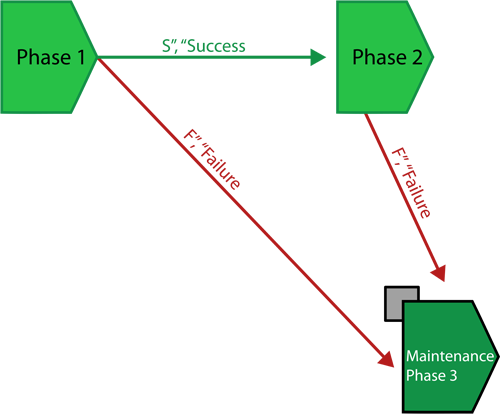
Maintenance phase has a CM with duration 80 hours and PM with duration 20 hours for both Block A and B.
Phase 1 has duration 100 hours and Phase 2 has duration 500 hours.
If there is no failure in Phase 1, upon finish, it goes to Phase 2. If there is a failure in Phase 1, it would go to Maintenance Phase 3 immediately. If there is no failure in Phase 2, upon finish, it goes back to Phase 1. If there is a failure in Phase 2, it would go to Maintenance Phase 3 immediately.
The Block Up/Down plot is as followings:
- At the first cycle (0-100 for Phase 1 and 200-600 for Phase 2), there is no failure, thus after Phase 2, Phase 1 is executed (back to Phase 1 after this cycle).
- At 616 (Phase 1 of the second cycle), Block A fails. System doesn't enter Maintenance Phase 3 immediately because in Phase 1, Block A and Block B are parallel. Only failure of Block A doesn't bring system down.
- At 700, after Phase 1, system goes into Phase 2. In Phase 2, failure of Block A (passed from Phase 1) bring the system down because in Phase 2, Block A is in series with Block B. Thus system goes into Maintenance Phase 3 immediately. Block B is not down, thus it gets PM with duration 20 hours. Block A gets CM with duration 100 hours.
- At 1669, Block A fails in Phase 2 which bring down the system and system goes into Maintenance Phase 3 immediately. Block A gets CM and Block B gets PM.
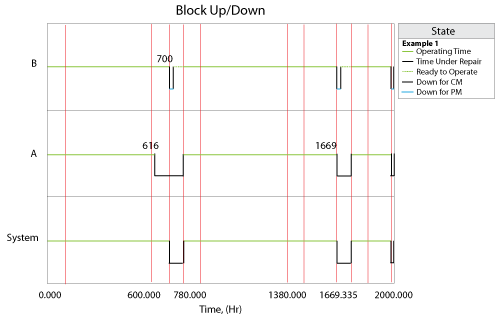
Example 2
The Phase diagram is as followings:
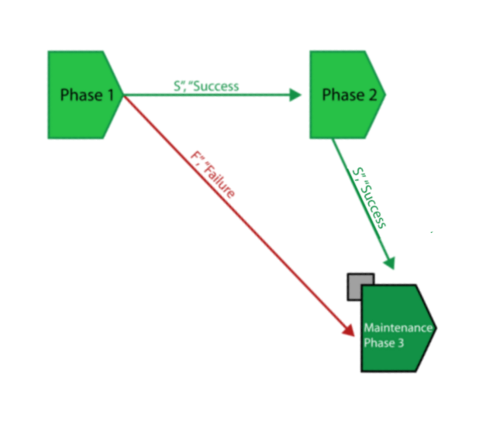
Everything is the same as that in Example 1 except that the path from Phase 2 to Maintenance Phase 3 changes from failure path to success path. This means that whether or not there is a failure in Phase 2, the system would go to Maintenance Phase 3 after Phase 2. But if there is a failure in Phase 2, system would go to Maintenance Phase 3 after Phase 2, not immediately.
The Block Up/Down plot is as followings:
- At 219, Block A fails in Phase 2. This failure brings the system down. However, since the path from Phase 2 to Maintenance Phase 3 is a success path, system doesn't go into Maintenance Phase 3 immediately. It would go into Maintenance Phase 3 after the Phase 2. Block A gets CM and Block B gets PM in there.
- At 1934, Block B fails in Phase 1. This failure doesn't bring system down because in Phase 1, system is in parallel structure. After Phase 1, system goes into Phase 2 and the failure of Block B brings system down in Phase 2. However, system doesn't go into Maintenance Phase 3 immediately because the path between them is success path. System goes into Maintenance Phase 3 after Phase 2 and Block B gets CM and Block A gets PM there.
